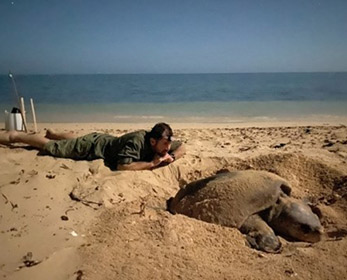Trapped and gripped by the neck, decapitations, and feeding on severed heads. These nightmarish visions are a grim reality for loggerhead turtle hatchlings.
Research from Edith Cowan University (ECU) and DBCA has exposed the predation practices of the golden ghost crab found on the west coast of Australia.
"Previous studies are mostly limited to evidence of loggerhead turtle nest disturbances and egg counts. While even fewer studies have investigated the mechanics of hatchling predation once they have emerged from the nest," ECU Adjunct Lecturer Dr Casper Avenant said.
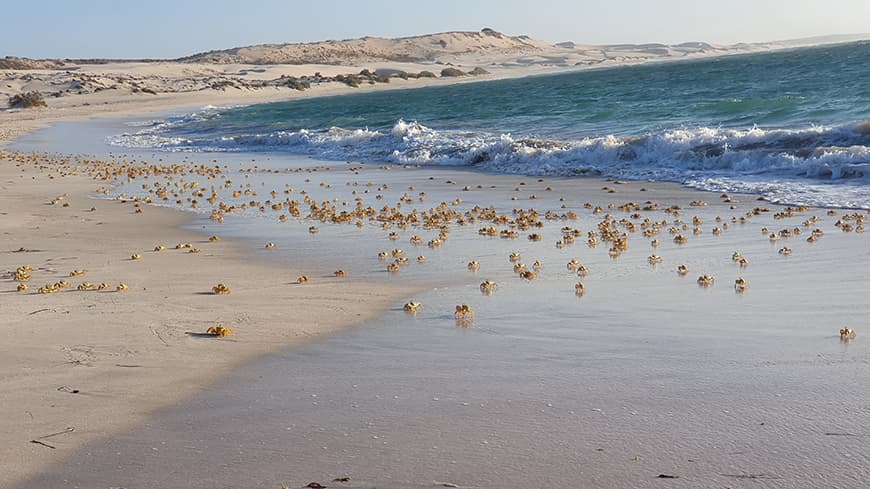 Golden ghost crabs can occur in high densities on Western Australian beaches. Image credit: Dr Casper Avenant, ECU and DBCA.
Golden ghost crabs can occur in high densities on Western Australian beaches. Image credit: Dr Casper Avenant, ECU and DBCA.
ECU Professor in Coastal Ecology, Glenn Hyndes said although ghost crabs are omnivores whose diet largely comprises leafy brown algae; they are proven to be a deadly enemy for sea turtle eggs and hatchlings during the nesting season. "On beaches where ghost crab densities are high, multiple crabs can feed on hatchlings emerging from nests over several nights, often resulting in partial destruction of turtle clutches," Professor Hyndes said.
"As an endangered species, a high level of predation of eggs and hatchlings could be an issue for the long-term survival of loggerhead turtle populations."
Infrared videography a huge benefit to research
Hatchling predation usually occurs at night, and at remote locations, and is notoriously difficult to capture without impacting natural behaviours.
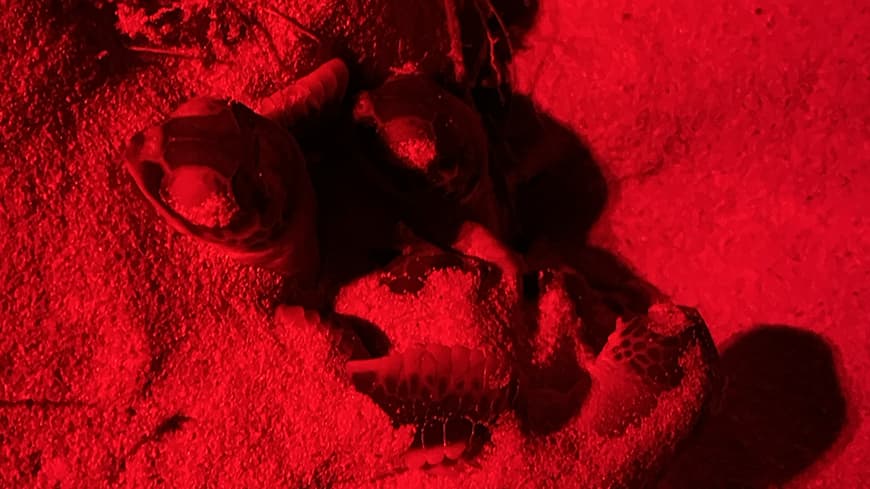 Loggerhead turtle hatchlings emerging from their nest. Image credit: Dr Casper Avenant, ECU and DBCA.
Loggerhead turtle hatchlings emerging from their nest. Image credit: Dr Casper Avenant, ECU and DBCA.
Using infrared videography, the researchers observed the feeding behaviour of golden ghost crabs along the Ningaloo Coast at Bungelup Beach and Gnaraloo Bay, and compared this to an aquarium setting at the Minderoo Exmouth Research Laboratory (MERL).
Dr Avenant said the golden ghost crab has been observed to snip a distinctive slit into eggshells through which the egg contents are consumed.
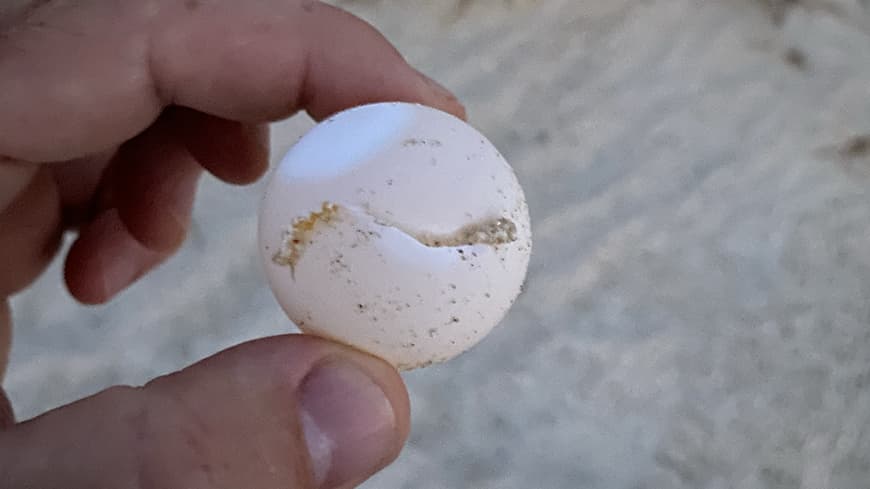 Dr Casper Avenant holds a loggerhead turtle egg predated by a golden ghost crab. Image credit: Dr Casper Avenant, ECU and DBCA.
Dr Casper Avenant holds a loggerhead turtle egg predated by a golden ghost crab. Image credit: Dr Casper Avenant, ECU and DBCA.
"Our findings have also revealed insights into the prey handling of ghost crabs when feeding on a turtle hatchling," Dr Avenant said.
When feeding on hatchlings, ghost crabs generally restrain hatchlings using the large claw to grip them around the neck, while the small claw cuts through the soft skin around the neck to partially or fully sever the head before feeding from the cavity.
"In terms of predator behaviour, it was interesting to note that ghost crabs display similar approaches for breaching eggshells when subduing and feeding on hatchlings.
"We also found that ghost crabs appear to anticipate the emergence of loggerhead hatchlings, often congregating near nests in the moments prior to emergence."
Loggerhead turtle hatchlings emerging from their nest. Image credit: Dr Casper Avenant, ECU and DBCA.
Dr Avenant said using infrared videography enabled researchers to successfully observe cryptic prey handling and feeding behaviours that may be compromised by more traditional observation methods. The technology has proven to be a powerful tool in both field and laboratory settings.
"Additionally, aquarium-based feeding assays showed the preference by ghost crabs for carrion or animal flesh over brown algae. This preference demonstrates that ghost crabs are effective predators of the early life phase of sea turtles," Dr Avenant said.
Where to next for loggerhead hatchlings?
"What I think needs to be better understood, given how effective the golden ghost crab is at predating endangered loggerhead turtle nests and hatchlings in WA, is whether the predation rates are too high. And if so, careful consideration is needed on whether this should this be mitigated.
"Sometimes it just sucks to be a loggerhead turtle hatchling. The question is: should we interfere?"
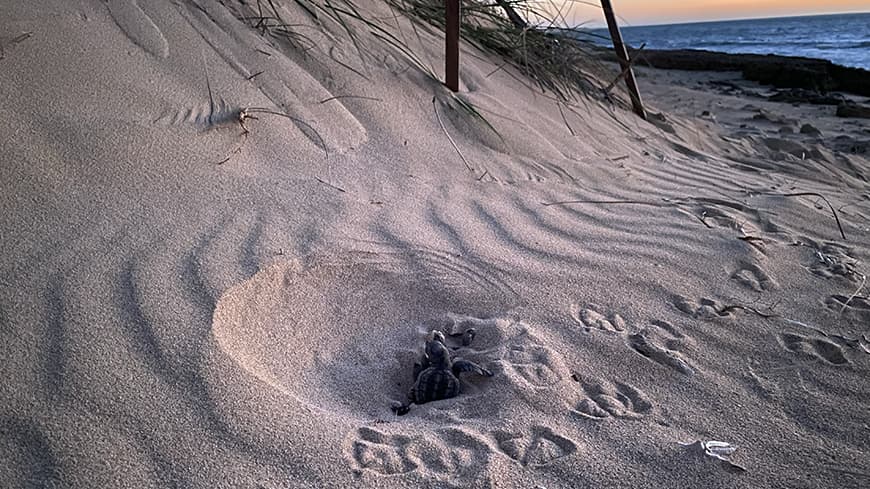 Hopeful loggerhead turtle hatchlings emerge from their nest at sunset. Image credit: Dr Casper Avenant, ECU and DBCA.
Hopeful loggerhead turtle hatchlings emerge from their nest at sunset. Image credit: Dr Casper Avenant, ECU and DBCA.
Previous research by Dr Avenant found that more than 35% of loggerhead eggs were predated within nests at Ningaloo, including 80% at a single rookery. Of the emerged hatchlings, 45% were predated.
The Department of Biodiversity, Conservation and Attractions co-funded the research and DBCA scientists were involved in the fieldwork and data collection.
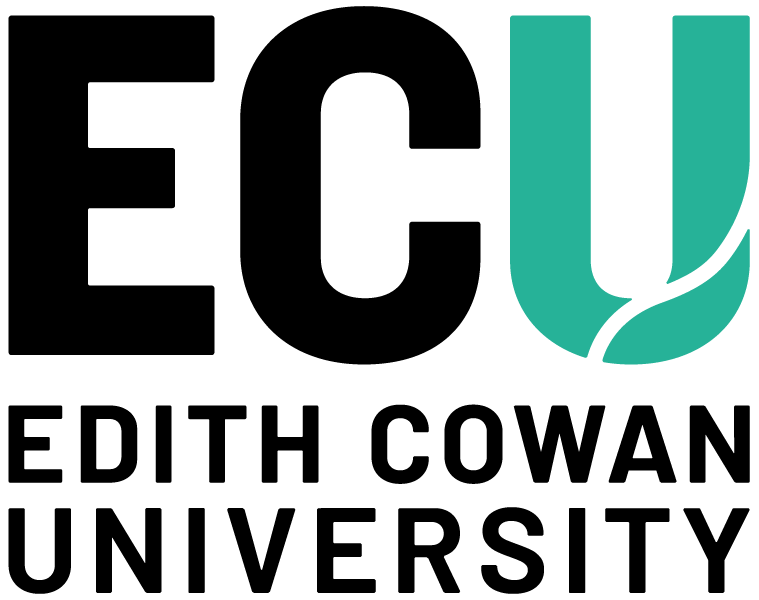
 Ocypode convexa commonly known as the "golden ghost crab" is endemic to the west coast of Australia. Image credit: Dr Casper Avenant, ECU and DBCA.
Ocypode convexa commonly known as the "golden ghost crab" is endemic to the west coast of Australia. Image credit: Dr Casper Avenant, ECU and DBCA.
